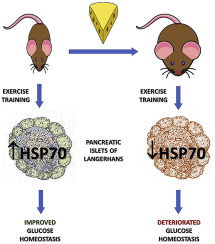Our official English website, www.x-mol.net, welcomes your
feedback! (Note: you will need to create a separate account there.)
Heat shock response to exercise in pancreatic islets of obese mice.
Biochimie ( IF 3.3 ) Pub Date : 2019-10-31 , DOI: 10.1016/j.biochi.2019.10.015 Aline Bittencourt 1 , Helena Trevisan Schroeder 1 , Rossana Rosa Porto 1 , Carlos Henrique de Lemos Muller 1 , Mauricio Krause 1 , Paulo Ivo Homem de Bittencourt 1
Biochimie ( IF 3.3 ) Pub Date : 2019-10-31 , DOI: 10.1016/j.biochi.2019.10.015 Aline Bittencourt 1 , Helena Trevisan Schroeder 1 , Rossana Rosa Porto 1 , Carlos Henrique de Lemos Muller 1 , Mauricio Krause 1 , Paulo Ivo Homem de Bittencourt 1
Affiliation

|
Chronic obesity imposes an organismal state of low-grade inflammation because the physiological resolution of inflammation is progressively repressed giving rise to cellular senescence and its accompanying Senescence-Associated Secretory Phenotype (SASP), which avoids apoptosis but perpetuates the relay of inflammatory signals from adipose tissue toward the rest of the body. Conversely, resolution of inflammation depends on the integrity of heat shock response (HSR) pathway that leads to the expression of cytoprotective and anti-inflammatory protein chaperones of the 70 kDa family (HSP70). However, chronic exposure to the aforementioned injuring factors leads to SASP, which, in turn, suppresses the HSR. A main metabolic tissue severely jeopardized by obesity-related dysfunctions is the endocrine pancreas, particularly β-cells of the islets of Langerhans. Because exercise is a powerful inducer of HSR and predicted to alleviate negative health outcomes of obesity, we sought whether obesity influence HSP70 expression in pancreatic islets and other metabolic tissues (adipose tissue and skeletal muscle) of adult B6.129SF2/J mice fed on a high-fat diet (HFD) for 13 weeks since the weaning and whether acute exercise as well as moderate-intensity exercise training (8 weeks) could interfere with this scenario. We showed that acute exercise of moderate intensity protects pancreatic islets against cytokine-induced cell death. In addition, acute exercise challenge time-dependently increased islet HSP70 that peaked at 12 h post-exercise in both trained and untrained mice fed on a control diet, suggesting an adequate HSR to exercise training. Unexpectedly, however, neither exercise training nor acute exercise challenges were able to increase islet HSP70 contents in trained mice submitted to HFD, but only in untrained HFD animals. In parallel, HFD disrupted glycemic status which is accompanied by loss of muscular mass resembling sarcopenic obesity that could not be rescued by exercise training. These results suggest that exercise influences HSR in pancreatic islets but obesity undermines islet, muscle and adipose tissue HSR, which is associated with metabolic abnormalities observed in such tissues.
中文翻译:

肥胖小鼠胰岛对运动的热休克反应。
慢性肥胖会导致机体处于低度炎症状态,因为炎症的生理学分辨率会逐渐受到抑制,从而引起细胞衰老及其伴随的衰老相关分泌表型(SASP),从而避免了细胞凋亡,但使脂肪组织的炎症信号得以延续朝向身体的其余部分。相反,炎症的解决取决于热休克反应(HSR)途径的完整性,该途径导致70 kDa家族(HSP70)的细胞保护和抗炎蛋白伴侣的表达。但是,长期暴露于上述伤害因素会导致SASP,进而抑制HSR。肥胖相关功能障碍严重危害的主要代谢组织是内分泌胰腺,尤其是Langerhans胰岛的β细胞。由于运动是HSR的有力诱因,并且预计可减轻肥胖对健康的负面影响,因此我们寻求肥胖是否会影响以B6,129SF2 / J成年小鼠喂养的成年小鼠的胰岛和其他代谢组织(脂肪组织和骨骼肌)中HSP70的表达。断奶后连续13周进行高脂饮食(HFD),以及急性运动以及中等强度的运动训练(8周)是否会干扰这种情况。我们表明中等强度的急性运动可以保护胰岛免受细胞因子诱导的细胞死亡。此外,急性运动挑战随时间增加的胰岛HSP70随时间增加,在接受对照饮食喂养的训练和未训练小鼠中均在运动后12 h达到峰值,表明有足够的HSR进行运动训练。不料,然而,运动训练和急性运动挑战均不能增加接受HFD训练的小鼠的胰岛HSP70含量,而仅在未经训练的HFD动物中增加。同时,HFD破坏了血糖状态,伴随着肌肉减少,类似于肌肉减少症,运动训练无法挽救。这些结果表明,运动会影响胰岛的HSR,但肥胖会破坏胰岛,肌肉和脂肪组织的HSR,这与在此类组织中观察到的代谢异常有关。HFD破坏了血糖状态,伴随着肌肉减少,类似于肌肉减少症,运动训练无法挽救。这些结果表明,运动会影响胰岛的HSR,但肥胖会破坏胰岛,肌肉和脂肪组织的HSR,这与在此类组织中观察到的代谢异常有关。HFD破坏了血糖状态,伴随着肌肉减少,类似于肌肉减少症,运动训练无法挽救。这些结果表明,运动会影响胰岛的HSR,但肥胖会破坏胰岛,肌肉和脂肪组织的HSR,这与在此类组织中观察到的代谢异常有关。
更新日期:2019-11-01
中文翻译:

肥胖小鼠胰岛对运动的热休克反应。
慢性肥胖会导致机体处于低度炎症状态,因为炎症的生理学分辨率会逐渐受到抑制,从而引起细胞衰老及其伴随的衰老相关分泌表型(SASP),从而避免了细胞凋亡,但使脂肪组织的炎症信号得以延续朝向身体的其余部分。相反,炎症的解决取决于热休克反应(HSR)途径的完整性,该途径导致70 kDa家族(HSP70)的细胞保护和抗炎蛋白伴侣的表达。但是,长期暴露于上述伤害因素会导致SASP,进而抑制HSR。肥胖相关功能障碍严重危害的主要代谢组织是内分泌胰腺,尤其是Langerhans胰岛的β细胞。由于运动是HSR的有力诱因,并且预计可减轻肥胖对健康的负面影响,因此我们寻求肥胖是否会影响以B6,129SF2 / J成年小鼠喂养的成年小鼠的胰岛和其他代谢组织(脂肪组织和骨骼肌)中HSP70的表达。断奶后连续13周进行高脂饮食(HFD),以及急性运动以及中等强度的运动训练(8周)是否会干扰这种情况。我们表明中等强度的急性运动可以保护胰岛免受细胞因子诱导的细胞死亡。此外,急性运动挑战随时间增加的胰岛HSP70随时间增加,在接受对照饮食喂养的训练和未训练小鼠中均在运动后12 h达到峰值,表明有足够的HSR进行运动训练。不料,然而,运动训练和急性运动挑战均不能增加接受HFD训练的小鼠的胰岛HSP70含量,而仅在未经训练的HFD动物中增加。同时,HFD破坏了血糖状态,伴随着肌肉减少,类似于肌肉减少症,运动训练无法挽救。这些结果表明,运动会影响胰岛的HSR,但肥胖会破坏胰岛,肌肉和脂肪组织的HSR,这与在此类组织中观察到的代谢异常有关。HFD破坏了血糖状态,伴随着肌肉减少,类似于肌肉减少症,运动训练无法挽救。这些结果表明,运动会影响胰岛的HSR,但肥胖会破坏胰岛,肌肉和脂肪组织的HSR,这与在此类组织中观察到的代谢异常有关。HFD破坏了血糖状态,伴随着肌肉减少,类似于肌肉减少症,运动训练无法挽救。这些结果表明,运动会影响胰岛的HSR,但肥胖会破坏胰岛,肌肉和脂肪组织的HSR,这与在此类组织中观察到的代谢异常有关。











































 京公网安备 11010802027423号
京公网安备 11010802027423号